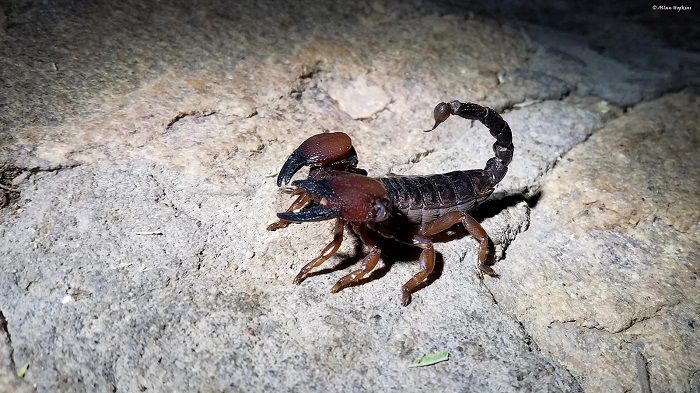Table of Contents
Overview
- Life Expectancy: 5-8 years
- Size (Adult): 3-3.5 inches
- Natural Habitat: Tanzania
- Scientific Name: Pandinus cavimanus
- Other Names: Red-claw scorpion
Housing
As with most pet scorpions, the red-claw will require a glass or plastic terrarium/tank. This should be a minimum of 18” x 18” x 12” for one adult so as to provide enough room for it to move about and hide. When choosing a terrarium for a scorpion , it is important to give more consideration to floor space than height as these creatures love to move about, dig, and burrow. Check out these great terrariums on Amazon – opens in a new tab.
, it is important to give more consideration to floor space than height as these creatures love to move about, dig, and burrow. Check out these great terrariums on Amazon – opens in a new tab.
You are going to need substrate in which your scorpion can burrow. This should be at minimum 2-3 inches deep. The best substrate options for a red-claw scorpion are:
- Humus bricks
- Potting soil (fertilizer-free)
- Compost (fertilizer-free)
- Peat mixed with orchid bark
- Peat moss.
It is also a good idea to provide hides for your scorpion. For this you can use rocks, driftwood, cork bark, damp moss, plant pots, or special reptile hides that can be purchased online (here are some on Amazon – opens in a new tab) or from a local reptile store. Artificial plants are not only great for decorating the tank, but they also provide another hiding place for your scorpion.
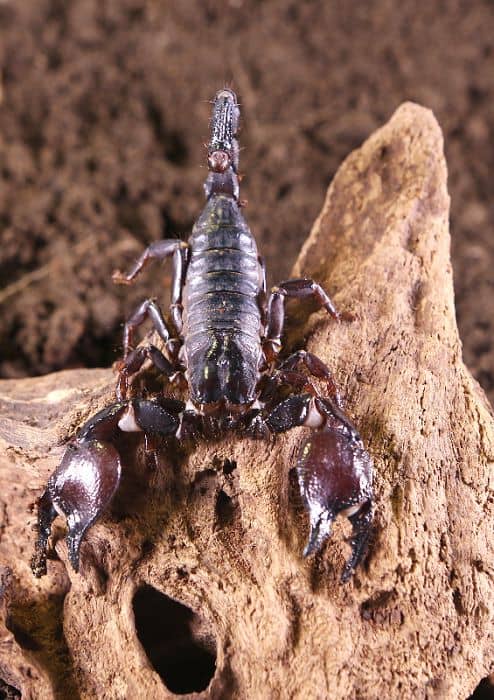
Heating and Lighting
It is important to maintain a warm temperature within your red-claw’s tank as these creatures hail from warmer climes in Africa. For this, you will require a heat lamp or heat mat. The temperature should be between 75F and 82F during the day, with a slight drop at night. To avoid your red-claw getting too hot, it is best to maintain a temperature gradient in the tank.
This can be achieved by using two heat lamps set at different temperatures at either ends of the tank or a heat mat placed under one third of the tank only (here is a selection of heating devices on Amazon – opens in a new tab).
on Amazon – opens in a new tab).
It is also important to ensure humidity levels are kept high, at around 75-80%. You can get the levels accurate by placing a water dish in the tank and by misting the enclosure every day. Note, however, that the substrate should be moist but not wet so as to avoid fungus and mold growth. If you have young scorpions in the tank, be sure to place pebbles or cotton wool in the water dish to help prevent accidental drowning.
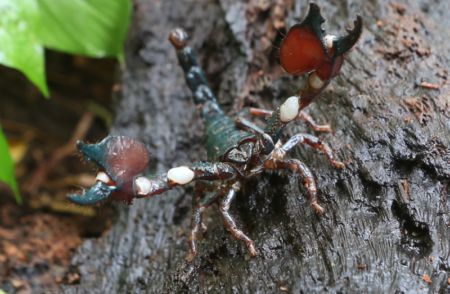
Feeding
Red-claw scorpions usually live on the forest floor of the tropical Tanzanian rainforest so feed on prey that includes a variety of insects, small mice, other rodents, and small frogs.
In captivity, the red-claw is typically fed on a diet of gut-loaded crickets, locusts, or hoppers. You can offer occasional treats such as dubia roaches or superworms. Red-claws can eat quite a lot at feeding time but will only require feeding every couple of days. Scorplings, on the other hand, should be fed daily. They enjoy eating pinhead crickets and mealworms. Remember to remove any uneaten food after an hour or two.
As strict carnivores, red-claw scorpions will only eat live prey, so fruit and vegetables should not be offered to your pet.
Handling
Red-claw scorpions can be quite aggressive, and when disturbed are likely to sting. It is therefore highly recommended that you do not try to handle them. It is best to use a net or ladle to scoop up your scorpion should you need to clean out the terrarium. Alternatively, move the scorpion into a small plastic tub by using the lid of that tub to coax it forward. When placing your scorpion into another tub to clean the terrarium, be sure to have a lid that has holes for ventilation.
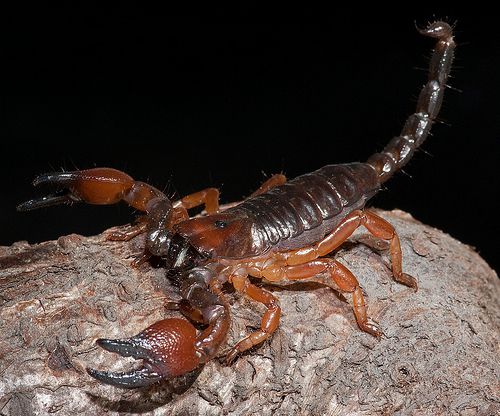
Health
To keep your red-claw scorpion healthy , it is crucial to ensure the right conditions at all times. Temperature and humidity levels are essential to their health and wellbeing, so it is vital that you invest in a good thermometer that also measures humidity. Amazon has a selection here – opens in a new tab.
, it is crucial to ensure the right conditions at all times. Temperature and humidity levels are essential to their health and wellbeing, so it is vital that you invest in a good thermometer that also measures humidity. Amazon has a selection here – opens in a new tab.
While red-claws do like a humid environment, too much humidity can actually lead to a condition known as mycosis, which can be fatal as it causes fungus to form near their book lungs. It is vital, therefore, to check your tank regularly to ensure there is no build up of fungus. You will also need to check over your scorpion once a week to make sure no fungus or mold has formed on its shell. If it has, you will need to wipe this away with a damp cotton swab. Your scorpion should then be placed in a dry environment for a week.
Healthy scorpions are alert and active and their exoskeletons should look healthy. They will eat regularly and have a full and rounded body. However, scorpions that are ill or unhealthy will appear quite different. The first indication of an ill scorpion will typically be a loss of appetite, although scorpions often stop eating before a molt as well, so loss of appetite is usually accompanied by other symptoms in a sick scorpion. These symptoms include:
- weight loss
- lethargy
- dull exoskeleton
- abnormal feces
- swollen limbs.
Should you notice the above symptoms, it is best to get in touch with a local exotic vet for information and advice.
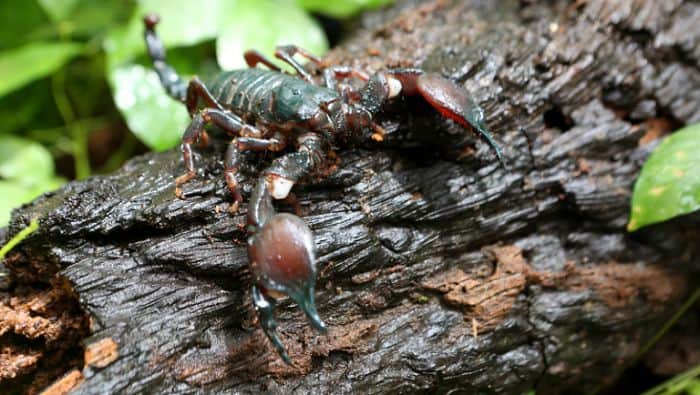
Do Red-Claw Scorpions Live Alone or in a Group?
Red-claw scorpions should be kept alone in captivity as they do not mix well with other scorpions, even those of their own species. In fact, they can be cannibalistic and will often fight each other to the death.
It may be possible to keep young red-claw scorpions together until the fifth molt, but after that they should be separated to avoid fighting with, and potentially eating, each other.
Breeding
Due to their aggressive nature, breeding red-claw scorpions can be very difficult for novice keepers. In the wild, these scorpions come together to mate by doing what looks like a dance. The pair will grasp each other, and the male will guide the female onto a flat surface before depositing his sperm there. He will then maneuver the female over the sperm deposit so that she can accept it into her genital opening. Once this occurs, the male must make a quick exit to avoid being attached and eaten.
If you are attempting to breed this species in captivity, it is important to sex the scorpions first. You can do this by comparing their genital openings to photos online. This is easiest done by looking at the scorpions from underneath a clear glass or plastic tub. When you are sure you have a male and female make sure they have both been well fed before introducing them to each other.
You will need to ensure that there is a flat surface in the enclosure on which the sperm can be deposited. It is important not to place the pair together and then leave them to it. You must monitor them to make sure they do not fight. As mentioned before, this species of scorpion has cannibalistic tendencies and have been known to eat each other.
If the pair start fighting, remove one immediately. You can try again another time. If they decide to mate, you will notice that they might wave their tails, tremble, and you should see the male trying to grasp the female’s chelae. If they do mate, you will see the male guide the female over the flat surface; once he retreats, the mating has finished. At this stage it is wise to remove the male immediately for his own safety.
If you successfully manage to breed a pair of red-claw scorpions, you will notice that the female grows larger as her pregnancy progresses. It is important to keep her on her own while she is gravid; gestation typically takes around nine months for scorpions. Scorpions give birth to live young and it is not uncommon for them to have up to thirty scorplings in one go.
When they are first born, scorplings have a white, almost transparent appearance and they will climb onto their mother’s back, upon which they will stay until their second molt. This usually takes around a week or two; it is essential you ensure a humid environment to help the molting process. The mother might not eat until the scorplings have left her back. It is at this point that they should be separated from the female.
Photo Credits:
- Featured Image (Tanzanian Red Clawed Scorpion- 3): https://www.flickr.com/photos/hoppy1951/33321194050/

- Tanzanian Red Clawed Scorpion- 2b: animalscene.ph
- Tanzanian Red Clawed Scorpion- 2a: animalscene.ph
- Tanzanian Red Clawed Scorpion- 1: pastimesreptilecentre.com
- Tanzanian Red Clawed Scorpion- 2c: animalscene.ph
Videos:
- 9 Red Claw Scorpion Facts & Care Tips
- Unpacking and Handling Pandinus cavimanus (Red Claw Scorpion)
- Red Claw Scorpion Tanzania

